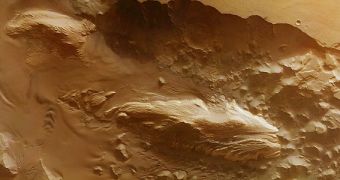Recent data collected by the European Space Agency's (ESA) Mars Express and the NASA Mars Reconnaissance Orbiter (MRO) spacecraft revealed that presence of a series of weird mounds inside a Martian landscape feature called Juventae Chasma.
These mounds appear to be made up of layered, light-toned materials, which have deposited in an area surrounded by a lot of sand and dust. The feature encompassing these mounds, Juventae Chasma, is believed to have developed around 3 billion years ago.
To the right of the image above, you can clearly see how the chasma walls collapsed on themselves, probably following volcanic activity at this location in the planet's distant geological past. This is believed to have caused a series of faults and fractures in the ground, which released groundwater.
A new body of water appeared at the bottom of the ravine, and started forming sulphate-rich materials that may have been deposited as mounds. Ice-laden dust in the Martian atmosphere may have also played a role in forming these structures, but more investigations are required to confirm this idea.

 14 DAY TRIAL //
14 DAY TRIAL //